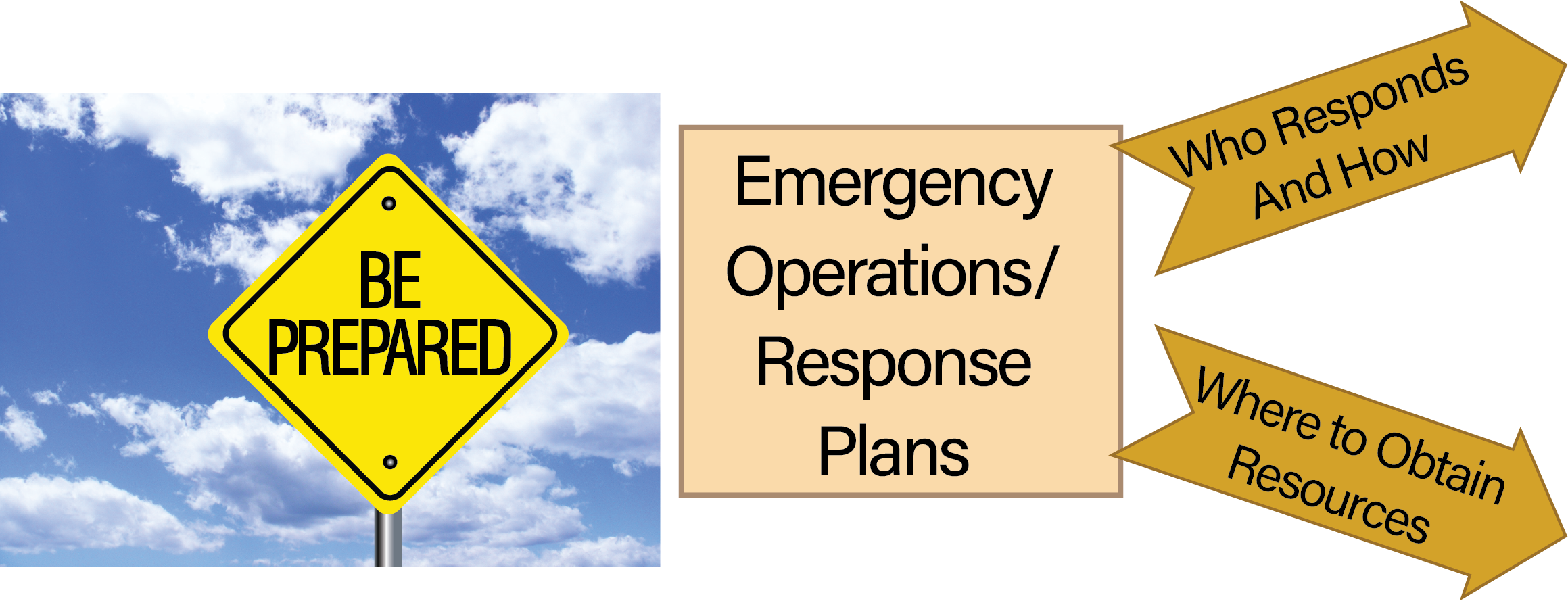1.3.2 Key factors
One key factor of emergency management is the formation of plans through which communities reduce exposure to hazards and manage disasters. emergency management does not prevent or eliminate threats or hazards. It focuses on creating plans, best management practices, and standardized operating procedures to decrease the impact of disasters.

Once threats and hazards have been identified, plans can be written. Plans generally address the areas of:
- Operations: what and how we execute our mission and responsibilities;
- Training: how we get people ready;
- Exercising: how we validate the plan and individual and team training;
- Post-response activities: how do we incorporate improvements.
Operations or response plans address:
- Who will respond and how they will be prepared to respond
- When response operations will commence and how they will be conducted
- How coordination will occur
- Communications plans
- Chain of command
- Organizational structures
- How response operations will terminate
- How improvements will be made
An objective of an Emergency Operations Plans (EOP) is to mitigate, prepare for, respond to, and recover from emergencies impacting transport Infrastructure. One example of an EOP is from Caltifornia’s Department of Transportation (Caltrans). Caltrans EOP is consistent with various United States federal emergency planning concepts, such as the Federal Emergency Management Agency (FEMA) National Response Framework (NRF), Federal and State Catastrophic Concept of Operations (CONOPS), and (Continuation of Operations/Continuation of Government (COOP/COG) Plans. The Caltrans EOP is centered on the California Standardized Emergency Management System (SEMS) and the Incident Command System (ICS) and is part of a larger framework that supports emergency management within the state of California. This larger framework is directed by the State of California Emergency Plan, hereinafter referred to as the SEP. The Caltrans EOP has the following purposes:
- Provides a central and unified resource for the planning for, and execution of, operations during an emergency, and the recovery following an emergency.
- Describes the manner in which Caltrans responds to and manages natural or human- caused emergencies, events, and incidents, including technological or nuclear related incidents and large non-emergency based events.
- The organization, functions and sections to which Headquarters and District personnel, their Divisions and Districts, may tentatively be assigned in their activated Headquarters Department Operations Center and District Emergency Operations Center during an emergency.
- Methods of preparation for, response to, and management of emergencies resulting from natural or human-caused disasters, technological incidents, nuclear related incidents or large events, including evacuations.
- Handling and reporting serious injuries or fatalities that occur during an employment activity of Caltrans employees or employees under contract with Caltrans.
- Caltrans' operations in the State Operations Center (SOC), the Regional Emergency Operations Centers (REOCs), and the various local Operational Areas, and its role in the State of California Emergency Plan.
- Funding and emergency administrative and financial guidelines, such as the procedures for requesting Director's Orders or resource allotment.
- Integrates and Coordinates the Emergency Management Concepts of Preparedness, Response, Recovery, and Mitigation with other Caltrans plans, manuals, and directives.
- Identifies its place in relation to the SEMS, and further describes the relationship of Caltrans' Emergency Operations to the 5 Primary Functions of the Incident Command System (ICS).
- Specifies the various alternate communication tools that may be used during or while managing an emergency that impacts the normal methods of communications.
Another aspect of emergency management that is sometimes overlooked but should be addressed, is human behavior. Human behavior in carrying out the emergency management mission should be addressed. How people actually react and why certain behaviors occur during emergencies should be mitigated in plans. We should accept what does happen and not what we want to believe happens. What we plan, and what people actually do is increasingly different. We should design systems to support what people actually do.


